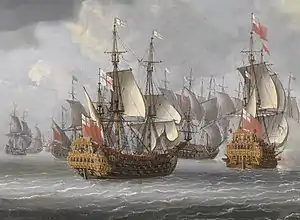Isaac Sailmaker
Isaac Sailmaker (born Isaac Zeilmaker in Scheveningen, Dutch Republic, 1633; died in London on 28 June 1721) was a Dutch marine painter of the Baroque period who had a long artistic career in Britain.


Very little is known about his life other than in notes made by the antiquary George Vertue, who consulted Sailmaker for biographical information on the life of Sir Peter Lely.[1] According to Vertue, Sailmaker came to London at a young age as a pupil of George Geldorp, a Flemist portraitist and art dealer; Lely was apparently also a pupil of Geldorp's at about the same time (circa 1643-5).[1]
A contemporary of the better-known Dutch marine painters, the van der Veldes, Sailmaker was eclipsed by them when they moved to London in the 1670s, but he outlived them and was still painting into his eighties.[2] He was one of Britain's earliest marine painters, earning the soubriquet "the father of British sea painting".[3] Vertue comments that Sailmaker "employed himself always in painting views, small and great, many sea-ports and ships about England" and calls him "a constant labourer", which suggests that he produced a large body of work during his lifetime.[4]
The attribution of Sailmaker's paintings has been problematic for many years due to the lack of a signed painting by him. Various works originally said to have been created by Sailmaker were later reattributed to Jacob Knyff. However, a painting of the second Eddystone Lighthouse before its destruction in 1755 was firmly attributed to Sailmaker in the 1970s on the basis of documentary evidence.[2][5] Other paintings have been attributed to him on the basis of engravings after his work.[6]
Works attributed to Sailmaker include ship portraits and depictions of various naval actions such as the 1704 Battle of Malaga. He is known to have received commissions from Oliver Cromwell and Colonel John Lovett, MP, though the works that he produced for them have been lost.[7] According to Vertue, Cromwell commissioned him to paint "a prospect of the Fleet before Mardyke when it was taken in 1657".[8]
Vertue was somewhat dismissive of Sailmaker's skill as a painter, calling him "not very excellent".[9] His style is distinctive for its reliance on a relatively narrow palette, principally black, greys and greens.[10] Sailmaker died on 28 June 1721 "at his home near the Riverside without the Temple Gate call'd the Kings bench Walks", according to Vertue.[6]
References
- Waterhouse, E.K.; Kitson, M. (1994). Painting in Britain, 1530 to 1790. The Yale University Press Pelican History of Art Series. Yale University Press. p. 92. ISBN 978-0-300-05833-8. Retrieved 2021-12-16.
- Archibald, E.H.H. (1989). Dictionary of Sea Painters. Antique Collectors' Club. p. 190. ISBN 978-1-85149-047-9. Retrieved 2021-12-14.
- Cockett, F.B.; Antique Collectors' Club (1995). Early Sea Painters: 1660-1730 : the Group who Worked in England Under the Shadow of the Van de Veldes. Antique Collectors' Club. ISBN 978-1-85149-230-5. Retrieved 2021-12-16.
- Cockett, p. 22
- Cordingly, D. (1997). Ships and Seascapes: Introduction to Maritime Prints, Drawings and Watercolours. Bloomsbury USA. p. 81. ISBN 978-0-85667-484-6. Retrieved 2021-12-16.
- Cordingly, D.; Brighton, Eng. Pavilion; Royal Pavilion, Art Gallery, and Museums (1979). Painters of the Sea: A Survey of Dutch and English Marine Paintings from British Collections. Painters of the Sea: A Survey of Dutch and English Marine Paintings from British Collections. Lund Humphries for the Royal Pavillion, Art Gallery and Museums, Brighton. p. 41. ISBN 978-0-85331-425-7. Retrieved 2021-12-16.
- "A Royal Yacht off Greenwich, about 1697". Government Art Collection. 2021-10-10. Retrieved 2021-12-16.
- Cordingly, D. (1974). Marine Painting in England, 1700-1900. C. N. Potter. p. 74. ISBN 978-0-517-51229-6. Retrieved 2021-12-16.
- Cockett, ibid
- "Isaac SAILMAKER (1633-1721, English)". Daniel Hunt Fine Art. 2018-07-31. Retrieved 2021-12-16.
| Wikimedia Commons has media related to Isaac Sailmaker. |